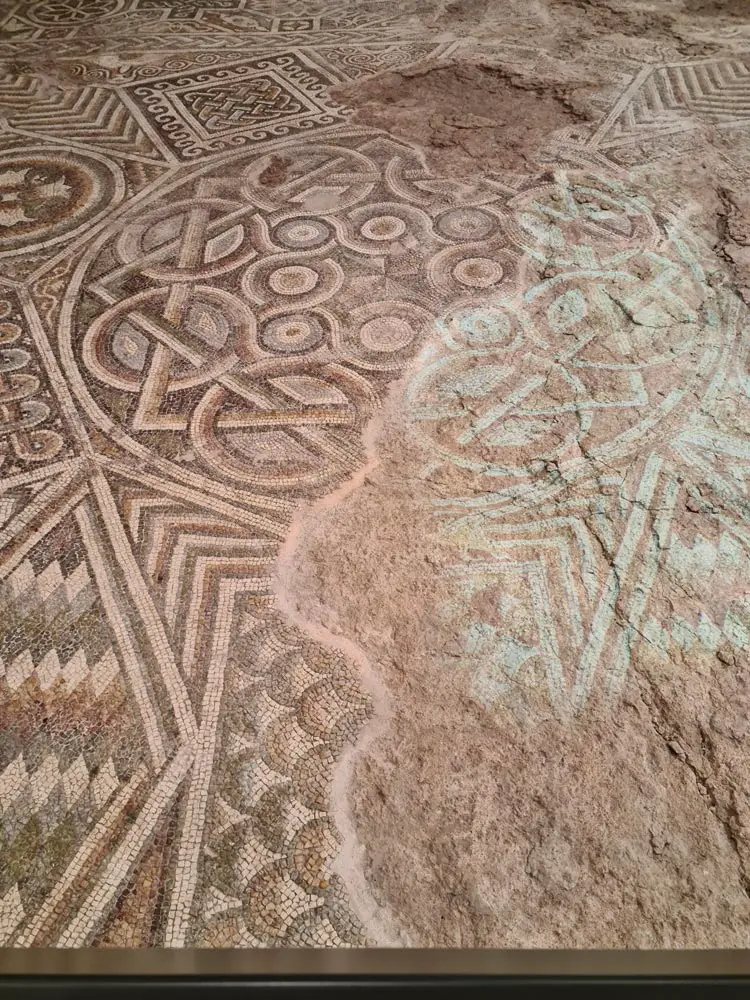Last Updated on 16.07.2023 by Iliyan
On April 18, 2021 was officially opened one of the biggest landmarks in Plovdiv and Bulgaria – The Bishop’s Basilica of Philippopolis, also known as the Great Basilica of Plovdiv. It is the largest Early Christian church in Bulgaria and an exceptional architectural monument of national importance, dating from the IV-VI century. The City of Seven Hills can be proud with this ancient museum complex, which is one of the best museums I have ever visited so far. Visiting the museum will allow you to dip into the history of Plovdiv from thousands of years ago, and leave you with a sense of euphoria from the vibrant masterpieces of the ancient artists.
Contents
How to Get to the Bishop’s Basilica of Philippopolis (The Great Basilica of Plovdiv)?
The Bishop’s Basilica of Philippopolis is located in the central part of the city, just 10 minutes walking from the Main Street (Glavnata). It is located on the lively Knyaginya Maria Luiza Blvd. 2, just opposite the Catholic Cathedral of St. Louis.
Historial facts about the Bishop’s Basilica of Philippopolis
According to archaeologists, between the 2nd and the 14th century, this place teemed with life. In the 2nd century, during the Roman Empire, there was a large temple with an oval structure here, probably dedicated to the imperial cult. The pagan temple was located in the central part of Philippopolis, mixing elements of Classical Greek and Roman architecture. At the end of the 4th century, the Bishop’s Basilica was built on the site of the pagan temple. In the beginning of the 7th century, the Great Basilica was abandoned, and some citizens built houses and settled over its ruins. Almost 300 years later, in the 10th century, they turned the site into a necropolis, where the locals buried people until the end of the 14th century. Then the place sank into oblivion.



The architecture of the Bishop’s Basilica of Philippopolis was impressive. The total length of the basilica is over 90 m and its width is 36 m. It included a central and two side naves (southern and northern), an apse, a narthex, and a colonnaded atrium. A marble-decorated presbyterium rose in the central nave. The interior of the Bishop’s Basilica of Philippopolis was beautifully decorated with Christian symbols on their capitals, frescoes and a magnificent mosaic floor. Nowadays, mosaics are the best preserved elements of the building.
The Mosaics of Philippopolis
As soon as you get in the Great Basilica of Plovdiv you will see the exquisite mosaics that will literally leave you breathless. They have a total area of 2,000 square meters, and the two mosaic layers are exposed on two levels. It is assumed that due to the earthquake the floor sank and subsequently, a second layer of mosaics was laid over it. They are extremely beautiful with different colors and shapes, geometrical ornaments and birds.


The 4th century mosaics of the first layer in the Bishop’s Basilica of Philippopolis are geometric, while the mosaics from the second layer (5th century) combined geometric ornaments birds, flowers and fruits. The mosaics in the central nave depict geometric shapes and patterns, usually in black, white and ocher types of colors. The first layer of mosaics in the two side naves are intricate geometric patterns and pagan symbols in an incredible combination of colors such as white, black, blue, green, brown, pink, ocher, etc. One of the mosaics in the museum provides you with the unique opportunity to see how it appeared in its original form with the use of light beams to project the complex shapes.





In the central panel of the two side naves contain the Spring of Life scene. The fountain in the center symbolizes Jesus and the idea that whoever drinks from it will attain eternal life.

The emblematic mosaic birds are the symbol of the Great Basilica. You can see more than 100 birds of 12 species, like Spur-winged goose, Egyptian goose, Indian peafowl, Rose-ringed parakeet, Ring-necked Pheasant, Chukar partridge, Western swamphen, Helmeted guineafowl, etc. Many of them were depicted around the Basilica’s altar, along with fruits, flowers and jugs of water, creating a picture of the Garden of Eden. The peacocks represent the immortality of the soul. It is no coincidence that a peacock with an opulent train is depicted in front of the main entrance of the basilica. He showed all visitors that Christianity is the path to eternal life.



The Great Basilica of Plovdiv Museum – Hours and Tickets Price
- Adult – 12.00 BGN
- Pupil or student – 5.00 BGN
- Family ticket (parents with children aged 7 to 16) – 24.00 BGN

Offers and Savings
- Adults when group of more than 10 people – 10.00 BGN
- Pupil or student when group of more than 10 people – 3.00 BGN
You can buy a combined ticket, which includes the Bishop’s Basilica of Philippopolis and the Small Basilica.
- Adult – 15.00 BGN
- Pupil or student – 6.00 BGN
Free visits:
- Every first Thursday of the month for students and retirees
- Children aged up to 7
- For disabled people (disability more than 50%)
*Free lockers are provided for visitors. The museum do not accept credit and debit cards.
Hours
The visitor centre is open seven days a week. You will need at least two hours to explore what’s on display at the Bishop’s Basilica of Philippopolis.
- November – March – 9.00 – 17.30
- April – October – 9.00 – 18.00
Until a few years ago, the Bishop’s Basilica of Philippopolis was an abandoned place. Thanks to America for Bulgaria Foundation and the Municipality of Plovdiv, today the modern museum building is a remarkable cultural center that can be touched by all residents of Plovdiv and guests of the city. It is equipped with interactive panels and virtual reality, and includes a children’s playground, a workshop for restorers and an exhibition space.



